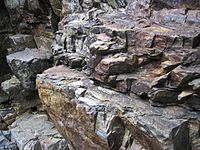
Photo from wikipedia
Earth surface evolution, like many natural phenomena typified by fluctuations on a wide range of scales and deterministic smoothing, results in a statistically rough surface. We present theory demonstrating that… Click to show full abstract
Earth surface evolution, like many natural phenomena typified by fluctuations on a wide range of scales and deterministic smoothing, results in a statistically rough surface. We present theory demonstrating that scaling exponents of topographic and stratigraphic statistics arise from long time averaging of noisy surface evolution rather than specific landscape evolution processes. This is demonstrated through use of “elastic” Langevin equations that generically describe disturbance from a flat earth surface using a noise term that is smoothed deterministically via sediment transport. When smoothing due to transport is a local process, the geologic record self-organizes such that a specific Sadler effect and topographic power spectral density (PSD) emerges. Variations in PSD slope reflect the presence or absence and character of nonlocality of sediment transport. The range of observed stratigraphic Sadler slopes captures the same smoothing feature combined with the presence of long-range spatial correlation in topographic disturbance.
Journal Title: Geophysical Research Letters
Year Published: 2017
Link to full text (if available)
Share on Social Media: Sign Up to like & get
recommendations!